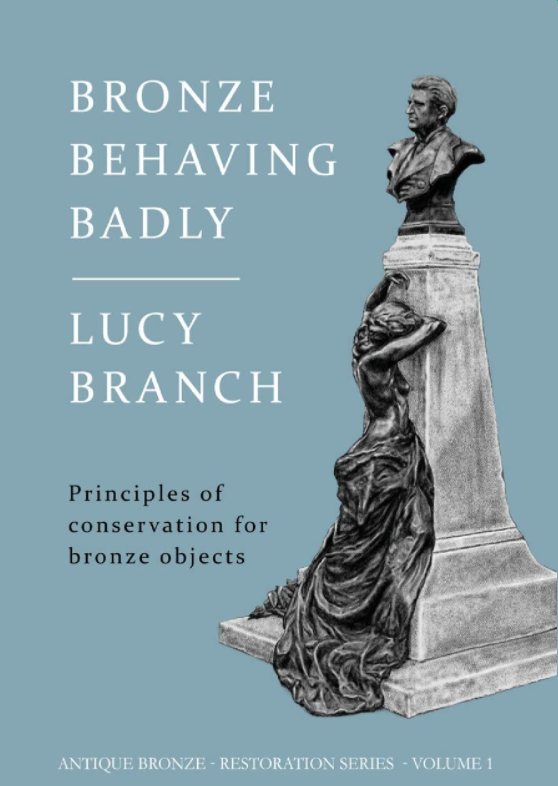Bronze Behaving Badly: principles of conservation for bronze objects
Bronze Behaving Badly: principles of conservation for bronze objects, Antique Bronze, Restoration Series, Volume 1, Lucy Branch, ABL Press, 2020, 190 pages, 38 colour illustrations.
‘The rules of conservation never preserved a bronze,’ advises bronze conservator Lucy Branch, extending 18th-century Scottish philosopher Thomas Reid’s quote about navigation and architecture to the ethical balancing act of science, art, integrity and sustainability for bronze conservation.
Branch is a director of Antique Bronze, a bronze restoration company, established in 1955 and specialising in sculpture and architectural features. She has worked on many high-profile bronze restoration projects, including Eros and the Shaftsbury Memorial, the Queen Victoria Memorial at Buckingham Palace, outdoor sculpture at Hampton Court Palace and the Barbara Hepworth Collection at Tate St Ives.
‘Bronze Behaving Badly’ is written for site managers, stakeholders, built heritage professionals, conservators and custodians. Branch’s writing is lively and accessible, yet it does not shy away from the chemistry and artistry of bronze sculpture and conservation. Throughout the book we are reminded about the value and benefits of regular inspection and maintenance. Part I covers the basic structure and ‘recipes’ for bronze, and guides readers through the process of creating bronze sculpture and architectural elements, finishing and applied patinas. The discussion includes historic and 21st-century methods, and highlights how things can go wrong in the process of creation and in the decades (or centuries) that follow the foundry finish. Simple sketches might have been helpful in this chapter to express some of the more abstract concepts.
Part II considers history and context, concepts ably demonstrated by illustrated case studies. Branch’s reflective approach to conservation elevates significance, presentation and archival research as central concerns for the ethics of conservation. I was pleased to find Part III devoted entirely to these concerns. ‘Bronze Behaving Badly’ includes a list of references by subject area and, critically, the Institute of Conservation’s (Icon) professional standards and judgements and ethics; essential reading for anyone commissioning or undertaking work on sculptural or architectural bronze. The value of documentation is considered, both as archival evidence to understand the creation processes, artistic intent and past treatments, and the responsibility for leaving behind our rationale for specifying work today.
Techniques and coatings are covered in Part IV, loosely organised from least interventive and reversible to more aggressive and irreversible treatments. Branch gets real about the value and limitations of chemical analysis, and highlights the value of experience, fieldwork, environmental awareness and archival research for assessing patina and other forms of corrosion. Refreshingly for a book about metals conservation, ‘Bronze Behaving Badly’ includes a section on poulticing treatments to remove bronze staining from stone.
The conclusion urges practitioners to reflect on the work that has been done, and make sure that sites are revisited to assess conditions and evaluate the performance of treatments. The message is clear: do your homework in the archives, evaluate significance, consider how people use or value the site, assess the environment, consider a range of treatments, and document both your decision-making processes and work.
This article originally appeared as ‘Reflect, revisit, evaluate’ in Context 169, published by the Institute of Historic Building Conservation (IHBC) in September 2021. It was written by Heather McGrath Alcock, SAHGB-funded PhD researcher, Liverpool School of Architecture.
--Institute of Historic Building Conservation
Related articles on Designing Buildings
IHBC NewsBlog
Images from inside a Grade II listed hotel show the scale of its collapse
The Corbett Arms in Tywyn has fallen into serious disrepair.
Old Sarum fire in listed (& disputed) WW1 Hangar - Wiltshire Council has sought legal advice after fire engulfed a listed First World War hangar that was embroiled in a lengthy planning dispute.
UK Antarctic Heritage Trust launches ‘Virtual Visit’ website area
The Trust calls on people to 'Immerse yourself in our heritage – Making Antarctica Accessible'
Southend Council pledge to force Kursaal owners to maintain building
The Council has pledged to use ‘every tool in the toolbox’ if urgent repairs are not carried out.
HE’s Research Magazine publishes a major study of the heritage of England’s suburbs
The article traces the long evolution of an internal programme to research 200 years of suburban growth
IHBC Context 183 Wellbeing and Heritage published
The issue explores issues at the intersection of heritage and wellbeing.
SAVE celebrates 50 years of campaigning 1975-2025
SAVE Britain’s Heritage has announced events across the country to celebrate bringing new life to remarkable buildings.
IHBC Annual School 2025 - Shrewsbury 12-14 June
Themed Heritage in Context – Value: Plan: Change, join in-person or online.
200th Anniversary Celebration of the Modern Railway Planned
The Stockton & Darlington Railway opened on September 27, 1825.
Competence Framework Launched for Sustainability in the Built Environment
The Construction Industry Council (CIC) and the Edge have jointly published the framework.















